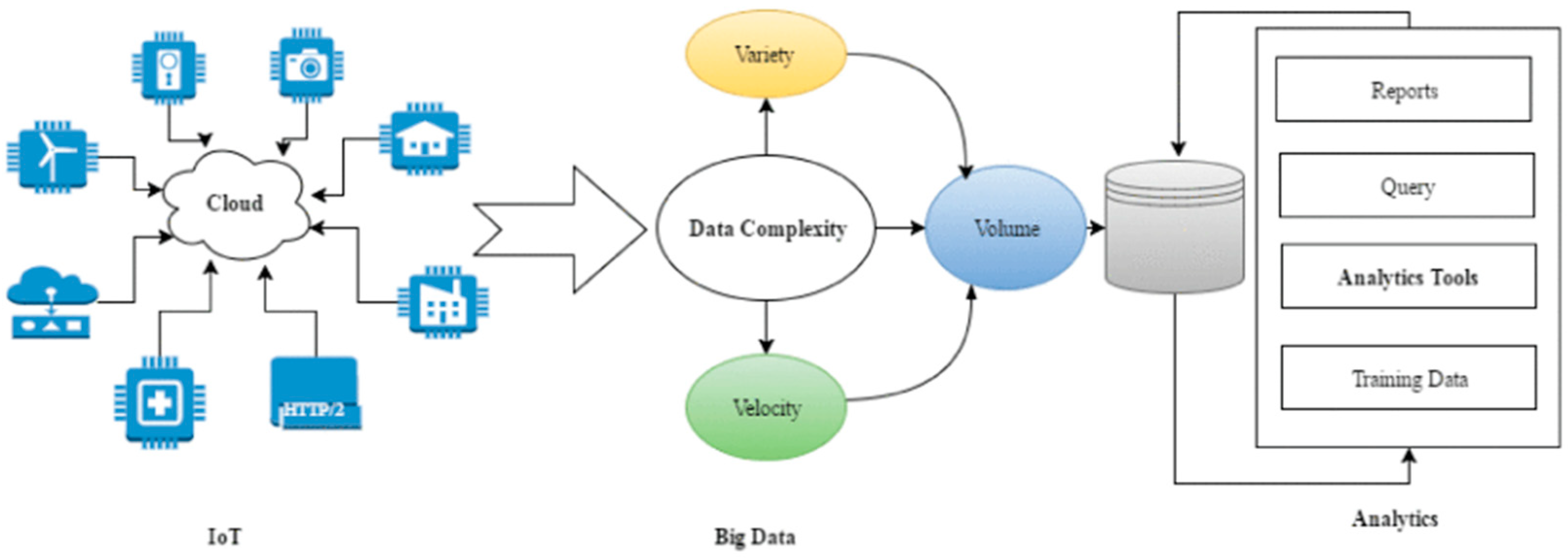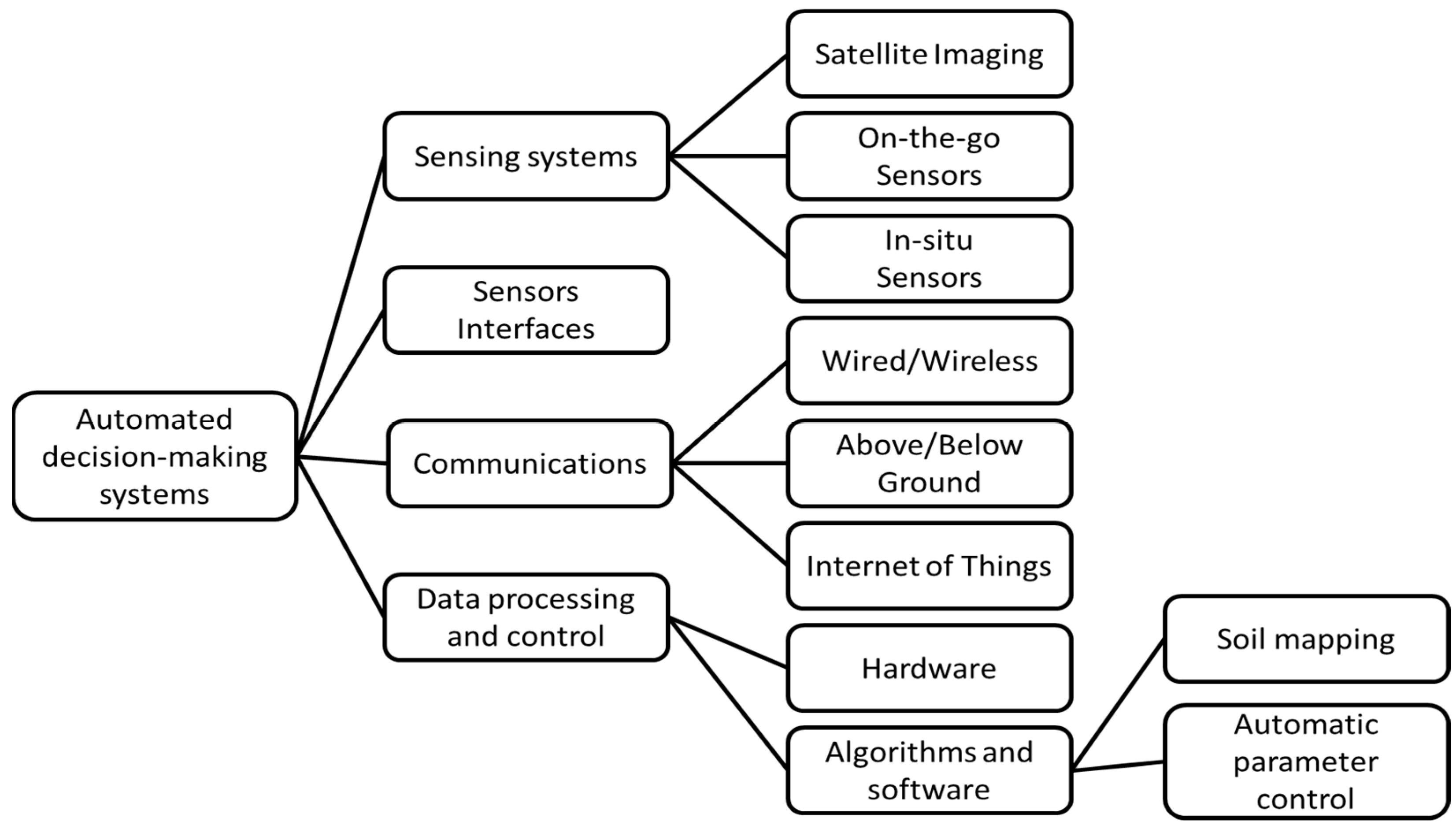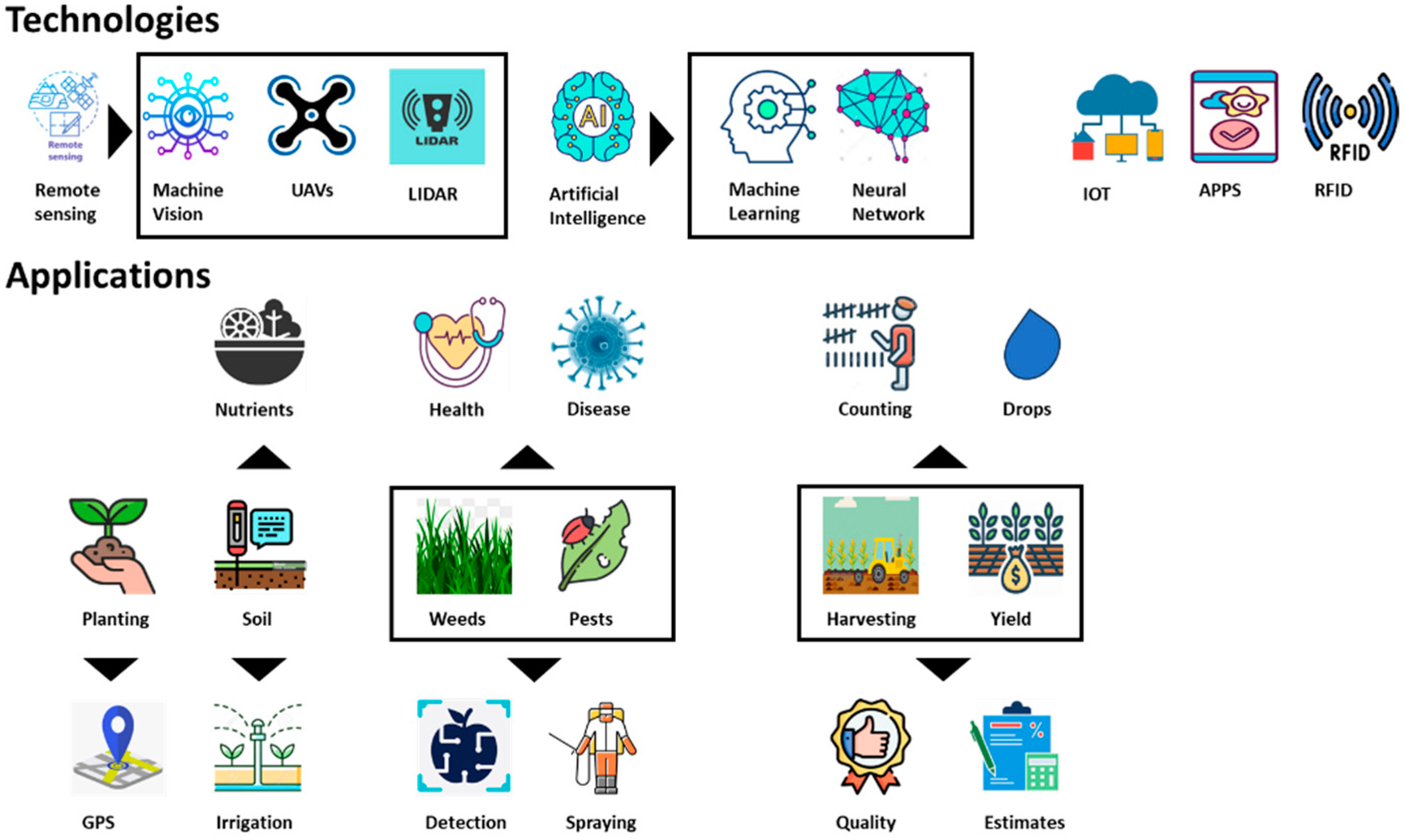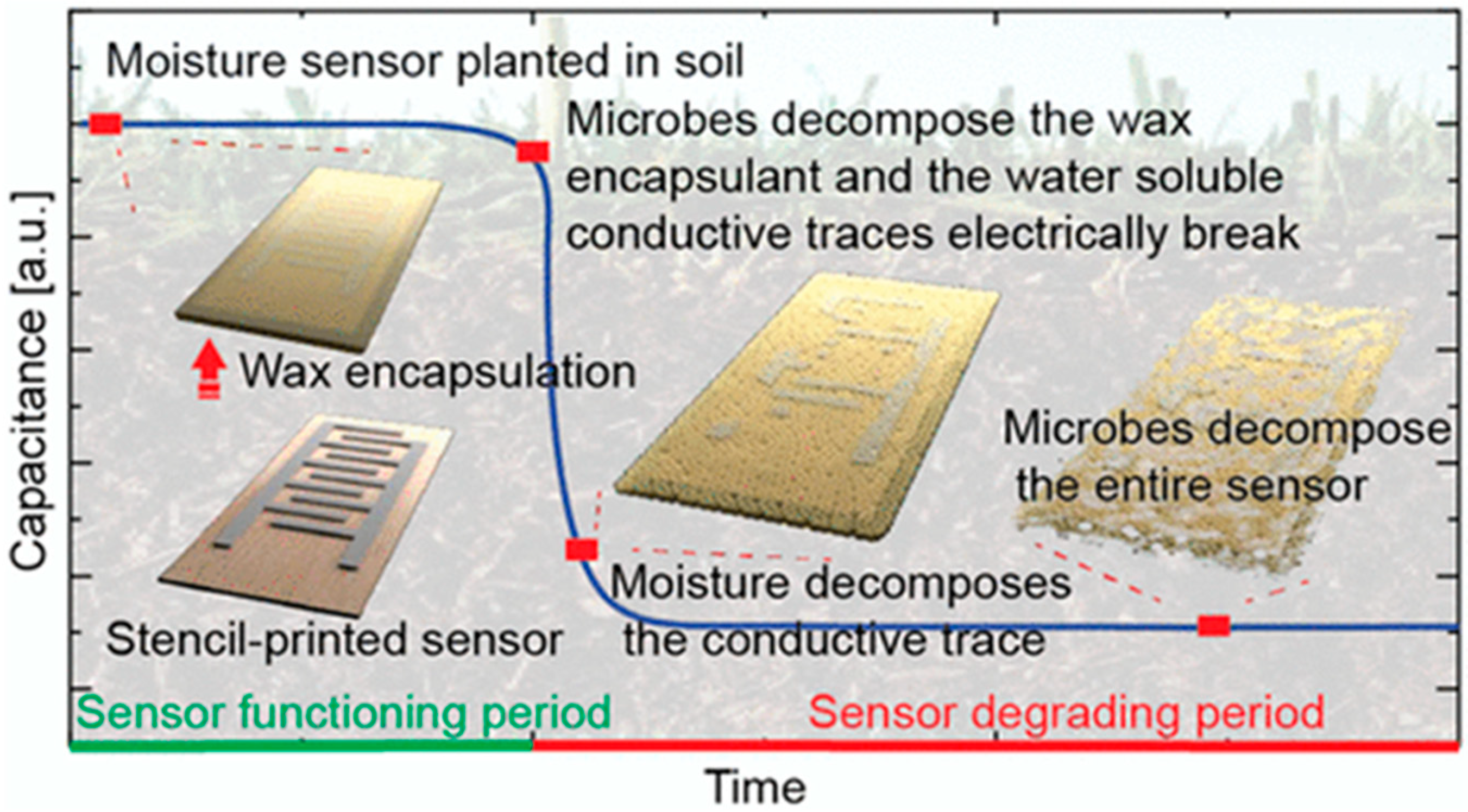Applying IoT Sensors and Big Data to Improve Precision Crop Production: A Review
Abstract
:1. Introduction
2. Overview of Precision Agriculture Technology
2.1. ICT, IoT, Big Data, Cloud Computing, and Data Fusion
2.2. AI, Real-Time Monitoring, and Big Data (Mining and Analyzing)
2.3. Sensor Development and Sensor Platforms
2.4. Data Transmission Technologies
3. Discussion
3.1. Amount of Needed Data for Precision Crop Production
3.2. Advantages and Disadvantages of IoT Sensors and Big Data in Precision Crop Production
4. Conclusions
Author Contributions
Funding
Acknowledgments
Conflicts of Interest
References
- Cukier, K.; Mayer-Schönberger, V. The Rise of Big Data: How It’s Changing the Way We Think about the World. In The Best Writing on Mathematics 2014; Princeton University Press: Princeton, NJ, USA, 2014; pp. 20–32. [Google Scholar]
- Bhat, S.A.; Huang, N.-F. Big Data and AI Revolution in Precision Agriculture: Survey and Challenges. IEEE Access 2021, 9, 110209–110222. [Google Scholar] [CrossRef]
- Zhang, N.; Wang, M.; Wang, N. Precision Agriculture—A Worldwide Overview. Comput. Electron. Agric. 2002, 36, 113–132. [Google Scholar] [CrossRef]
- Yost, M.A.; Kitchen, N.R.; Sudduth, K.A.; Sadler, E.J.; Drummond, S.T.; Volkmann, M.R. Long-Term Impact of a Precision Agriculture System on Grain Crop Production. Precis. Agric. 2017, 18, 823–842. [Google Scholar] [CrossRef]
- Khosla, R. Precision Agriculture: Challenges and Opportunities in a Flat World. In Proceedings of the 19th World Congress of Soil Science, Soil Solutions for a Changing World, Brisbane, QLD, Australia, 1–6 August 2010. [Google Scholar]
- McBratney, A.; Whelan, B.; Ancev, T.; Bouma, J. Future Directions of Precision Agriculture. Precis. Agric. 2005, 6, 7–23. [Google Scholar] [CrossRef]
- Bendre, M.R.; Thool, R.C.; Thool, V.R. Big Data in Precision Agriculture: Weather Forecasting for Future Farming. In Proceedings of the 2015 1st International Conference on Next Generation Computing Technologies (NGCT), Dehradun, India, 4–5 September 2015; pp. 744–750. [Google Scholar]
- Wolfert, S.; Ge, L.; Verdouw, C.; Bogaardt, M.-J. Big Data in Smart Farming—A Review. Agric. Syst. 2017, 153, 69–80. [Google Scholar] [CrossRef]
- Alexopoulos, A.; Koutras, K.; Ali, S.B.; Puccio, S.; Carella, A.; Ottaviano, R.; Kalogeras, A. Complementary Use of Ground-Based Proximal Sensing and Airborne/Spaceborne Remote Sensing Techniques in Precision Agriculture: A Systematic Review. Agronomy 2023, 13, 1942. [Google Scholar] [CrossRef]
- Ludena, R.D.A.; Ahrary, A. Big Data Approach in an ICT Agriculture Project. In Proceedings of the 2013 International Joint Conference on Awareness Science and Technology & Ubi-Media Computing (iCAST 2013 & UMEDIA 2013), Aizu-Wakamatsu, Japan, 2–4 November 2013; pp. 261–265. [Google Scholar]
- Nyéki, A.; Milics, G.K.A.J.; Neményi, M. Improving Yield Advisory Models for Precision Agriculture with Special Regards to Soil Compaction in Maize Production. In Precision Agriculture ’13; Stafford, J.V., Ed.; Wageningen Academic Publishers: Wageningen, The Netherlands, 2013; pp. 443–450. [Google Scholar]
- Nyéki, A.; Milics, G.; Kovács, A.J.; Neményi, M. Effects of Soil Compaction on Cereal Yield. Cereal Res. Commun. 2017, 45, 1–22. [Google Scholar] [CrossRef]
- Bermeo-Almeida, O.; Cardenas-Rodriguez, M.; Samaniego-Cobo, T.; Ferruzola-Gómez, E.; Cabezas-Cabezas, R.; Bazán-Vera, W. Blockchain in Agriculture: A Systematic Literature Review. In Technologies and Innovation; Valencia-García, R., Alcaraz-Mármol, G., Del Cioppo-Morstadt, J., Vera-Lucio, N., Bucaram-Leverone, M., Eds.; Springer International Publishing: Cham, Switzerland, 2018; pp. 44–56. [Google Scholar]
- Kamilaris, A.; Fonts, A.; Prenafeta-Boldύ, F.X. The Rise of Blockchain Technology in Agriculture and Food Supply Chains. Trends Food Sci. Technol. 2019, 91, 640–652. [Google Scholar] [CrossRef]
- Vangala, A.; Das, A.K.; Kumar, N.; Alazab, M. Smart Secure Sensing for IoT-Based Agriculture: Blockchain Perspective. IEEE Sens. J. 2021, 21, 17591–17607. [Google Scholar] [CrossRef]
- Mark, R. Ethics of Using AI and Big Data in Agriculture: The Case of a Large Agriculture Multinational. ORBIT J. 2019, 2, 1–27. [Google Scholar] [CrossRef]
- Kim, H.; Laskowski, M. Agriculture on the Blockchain: Sustainable Solutions for Food, Farmers, and Financing. In Supply Chain Revolution, Barrow Books 2018; Brilliance Audio: Grand Haven, MI, USA, 2017. [Google Scholar] [CrossRef]
- Rajeswari, S.; Suthendran, K.; Rajakumar, K. A Smart Agricultural Model by Integrating IoT, Mobile and Cloud-Based Big Data Analytics. In Proceedings of the 2017 International Conference on Intelligent Computing and Control (I2C2), Coimbatore, India, 23–24 June 2017; pp. 1–5. [Google Scholar]
- Vermesan, O.; Harrison, M.; Vogt, H.; Kalaboukas, K.; Tomasella, M.; Wouters, K. Cluster of European Research Projects on the Internet of Things: Vision and Challenges for Realising the Internet of Things; European Commission: Luxembourg, 2010. [Google Scholar]
- Ali, A.; Hussain, T.; Tantashutikun, N.; Hussain, N.; Cocetta, G. Application of Smart Techniques, Internet of Things and Data Mining for Resource Use Efficient and Sustainable Crop Production. Agriculture 2023, 13, 397. [Google Scholar] [CrossRef]
- Chugh, M.; Chugh, N. Essentials of Internet of Things in Smart Agriculture. In Applications of AI, Digital Twin, and Internet of Things for Sustainable Development; IGI Global: Hershey, PA, USA, 2023; pp. 186–199. [Google Scholar]
- Kumar, R.; Narayanan, S.; Kaur, G. Future of Internet of Everything (IOE). Int. Res. J. Comput. Sci. 2021, 8, 84–92. [Google Scholar] [CrossRef]
- Baldassarre, G.; Giudice, P.L.; Musarella, L.; Ursino, D. A Paradigm for the Cooperation of Objects Belonging to Different IoTs. In Proceedings of the 22nd International Database Engineering & Applications Symposium on—IDEAS 2018, Villa San Giovanni, Italy, 18–20 June 2018; ACM Press: New York, NY, USA, 2018; pp. 157–164. [Google Scholar]
- Jaiganesh, S.; Gunaseelan, K.; Ellappan, V. IOT Agriculture to Improve Food and Farming Technology. In Proceedings of the 2017 Conference on Emerging Devices and Smart Systems (ICEDSS), Mallasamudram, India, 3–4 March 2017; pp. 260–266. [Google Scholar]
- Stubbs, M. Irrigation in US Agriculture: On-Farm Technologies and Best Management Practices. Congressional Research Service. 2016. Available online: http://nationalaglawcenter.org/wp-content/uploads/assets/crs/R44158.pdf (accessed on 11 February 2023).
- Pham, X.; Stack, M. How Data Analytics Is Transforming Agriculture. Bus. Horiz. 2018, 61, 125–133. [Google Scholar] [CrossRef]
- Hussain, T.; Hussain, N.; Ahmed, M.; Nualsri, C.; Duangpan, S. Responses of Lowland Rice Genotypes under Terminal Water Stress and Identification of Drought Tolerance to Stabilize Rice Productivity in Southern Thailand. Plants 2021, 10, 2565. [Google Scholar] [CrossRef] [PubMed]
- Searcy, S.W. Precision Farming: A New Approach to Crop Management. Texas Agricultural Extension Service; Texas A&M University: College Station, TX, USA, 1997. [Google Scholar]
- Brisco, B.; Brown, R.J.; Hirose, T.; McNairn, H.; Staenz, K. Precision Agriculture and the Role of Remote Sensing: A Review. Can. J. Remote Sens. 1998, 24, 315–327. [Google Scholar] [CrossRef]
- Grisso, R.D.; Alley, M.M.; McClellan, P.; Brann, D.E.; Donohue, S.J. Precision Farming: A Comprehensive Approach. 2005. Available online: http://hdl.handle.net/10919/51373 (accessed on 15 March 2023).
- Tsai, C.-W.; Lai, C.-F.; Chiang, M.-C.; Yang, L.T. Data Mining for Internet of Things: A Survey. IEEE Commun. Surv. Tutor. 2014, 16, 77–97. [Google Scholar] [CrossRef]
- Marjani, M.; Nasaruddin, F.; Gani, A.; Karim, A.; Hashem, I.A.T.; Siddiqa, A.; Yaqoob, I. Big IoT Data Analytics: Architecture, Opportunities, and Open Research Challenges. IEEE Access 2017, 5, 5247–5261. [Google Scholar] [CrossRef]
- Patil, V.C.; Al-Gaadi, K.A.; Biradar, D.P.; Rangaswamy, M. Internet of Things (Iot) and Cloud Computing for Agriculture: An Overview. In Proceedings of the Agro-Informatics and Precision Agriculture (AIPA 2012), Hyderabad, India, 1–3 August 2012; pp. 292–296. [Google Scholar]
- Neményi, M.; Kovács, A.J.; Oláh, J.; Popp, J.; Erdei, E.; Harsányi, E.; Ambrus, B.; Teschner, G.; Nyéki, A. Challenges of Sustainable Agricultural Development with Special Regard to Internet of Things: Survey. Progress. Agric. Eng. Sci. 2022, 18, 95–114. [Google Scholar] [CrossRef]
- Yu, S.; Zhu, J.; Zhou, J.; Cheng, J.; Bian, X.; Shen, J.; Wang, P. Key Technology Progress of Plant-Protection UAVs Applied to Mountain Orchards: A Review. Agronomy 2022, 12, 2828. [Google Scholar] [CrossRef]
- Klein, L.A. Sensor and Data Fusion Concepts and Applications; Society of Photo-Optical Instrumentation Engineers (SPIE): Bellingham, WA, USA, 1999; ISBN 0819432318. [Google Scholar]
- Khaleghi, B.; Khamis, A.; Karray, F.O.; Razavi, S.N. Multisensor Data Fusion: A Review of the State-of-the-Art. Inf. Fusion 2013, 14, 28–44. [Google Scholar] [CrossRef]
- Waltz, E. Data Fusion for C3I: A Tutorial. In Command, Control, Communications Intelligence (C3I) Handbook; EW Communications: Palo Alto, CA, USA, 1986; pp. 217–226. [Google Scholar]
- Hall, D.L.; Llinas, J. An Introduction to Multisensor Data Fusion. Proc. IEEE 1997, 85, 6–23. [Google Scholar] [CrossRef]
- Casian, T.; Nagy, B.; Kovács, B.; Galata, D.L.; Hirsch, E.; Farkas, A. Challenges and Opportunities of Implementing Data Fusion in Process Analytical Technology—A Review. Molecules 2022, 27, 4846. [Google Scholar] [CrossRef]
- Munnaf, M.A.; Haesaert, G.; Van Meirvenne, M.; Mouazen, A.M. Multi-Sensors Data Fusion Approach for Site-Specific Seeding of Consumption and Seed Potato Production. Precis. Agric. 2021, 22, 1890–1917. [Google Scholar] [CrossRef]
- Foley, J.A.; Ramankutty, N.; Brauman, K.A.; Cassidy, E.S.; Gerber, J.S.; Johnston, M.; Mueller, N.D.; O’Connell, C.; Ray, D.K.; West, P.C.; et al. Solutions for a Cultivated Planet. Nature 2011, 478, 337–342. [Google Scholar] [CrossRef]
- Nyéki, A.; Kerepesi, C.; Daróczy, B.; Benczúr, A.; Milics, G.; Nagy, J.; Harsányi, E.; Kovács, A.J.; Neményi, M. Application of Spatio-Temporal Data in Site-Specific Maize Yield Prediction with Machine Learning Methods. Precis. Agric. 2021, 22, 1397–1415. [Google Scholar] [CrossRef]
- Elgaali, E.; Garcia, L. Neural Network Modeling of Climate Change Impacts on Irrigation Water Supplies in Arkansas River Basin. In Proceedings of the 24th Annual Hydrology Days, Fort Collins, CO, USA, 10–12 March 2004. [Google Scholar]
- Pantazi, X.E.; Moshou, D.; Alexandridis, T.; Whetton, R.L.; Mouazen, A.M. Wheat Yield Prediction Using Machine Learning and Advanced Sensing Techniques. Comput. Electron. Agric. 2016, 121, 57–65. [Google Scholar] [CrossRef]
- Iizumi, T.; Shin, Y.; Kim, W.; Kim, M.; Choi, J. Global Crop Yield Forecasting Using Seasonal Climate Information from a Multi-Model Ensemble. Clim. Serv. 2018, 11, 13–23. [Google Scholar] [CrossRef]
- Chamara, N.; Islam, M.D.; Bai, G. (Frank); Shi, Y.; Ge, Y. Ag-IoT for Crop and Environment Monitoring: Past, Present, and Future. Agric. Syst. 2022, 203, 103497. [Google Scholar] [CrossRef]
- Marios, S.; Georgiou, J. Precision Agriculture: Challenges in Sensors and Electronics for Real-Time Soil and Plant Monitoring. In Proceedings of the 2017 IEEE Biomedical Circuits and Systems Conference (BioCAS), Torino, Italy, 19–21 October 2017; pp. 1–4. [Google Scholar]
- Syvitski, J.P.M.; Overeem, I.; Brakenridge, G.R.; Hannon, M. Floods, Floodplains, Delta Plains—A Satellite Imaging Approach. Sediment. Geol. 2012, 267–268, 1–14. [Google Scholar] [CrossRef]
- Adamchuk, V.I.; Hummel, J.W.; Morgan, M.T.; Upadhyaya, S.K. On-the-Go Soil Sensors for Precision Agriculture. Comput. Electron. Agric. 2004, 44, 71–91. [Google Scholar] [CrossRef]
- Ho, C.; Hughes, R. In-Situ Chemiresistor Sensor Package for Real-Time Detection of Volatile Organic Compounds in Soil and Groundwater. Sensors 2002, 2, 23–34. [Google Scholar] [CrossRef]
- Hooper, D.U.; Embertson, N.; Sheibley, R.W.; Senter, C.; Compton, J.; Lin, J.; Homann, P.; Bittman, S. Promise and Problems of Real-Time Nitrate Monitoring for Watershed N Budgets. In Proceedings of the AGU Fall Meeting Abstracts, San Francisco, CA, USA, 9–13 December 2019; Volume 2019, p. GC51N–1163. [Google Scholar]
- Burton, L.; Dave, N.; Fernandez, R.E.; Jayachandran, K.; Bhansali, S. Smart Gardening IoT Soil Sheets for Real-Time Nutrient Analysis. J. Electrochem. Soc. 2018, 165, B3157–B3162. [Google Scholar] [CrossRef]
- Mouazen, A.M.; Maleki, M.R.; De Baerdemaeker, J.; Ramon, H. On-Line Measurement of Some Selected Soil Properties Using a VIS–NIR Sensor. Soil. Tillage Res. 2007, 93, 13–27. [Google Scholar] [CrossRef]
- Kamilaris, A.; Prenafeta-Boldú, F.X. Deep Learning in Agriculture: A Survey. Comput. Electron. Agric. 2018, 147, 70–90. [Google Scholar] [CrossRef]
- Balamurugan, S.; Divyabharathi, N.; Jayashruthi, K.; Bowiya, M.; Shermy, R.P.; Shanker, R. Internet of Agriculture: Applying IoT to Improve Food and Farming Technology. Int. Res. J. Eng. Technol. (IRJET) 2016, 3, 713–719. [Google Scholar]
- Wang, P.; Tian, J.; Niu, H.; Chen, Y. Smart Agricultural In-Field Service Robot: From Toy to Tool. In Proceedings of the Volume 9: 15th IEEE/ASME International Conference on Mechatronic and Embedded Systems and Applications; American Society of Mechanical Engineers, Anaheim, CA, USA, 18 August 2019. [Google Scholar]
- Bhatta, N.P.; Thangadurai, N. Utilization of IoT and AI for Agriculture Applications. Int. J. Eng. Adv. Technol. 2019, 8, 2731–2735. [Google Scholar]
- Abd El-Mawla, N.; Badawy, M.; Arafat, H. IoT for the Failure of Climate-Change Mitigation and Adaptation and IIoT as a Future Solution. World J. Environ. Eng. 2019, 6, 7–16. [Google Scholar] [CrossRef]
- Harsányi, E.; Bashir, B.; Almhamad, G.; Hijazi, O.; Maze, M.; Elbeltagi, A.; Alsalman, A.; Enaruvbe, G.O.; Mohammed, S.; Szabó, S. GHGs Emission from the Agricultural Sector within EU-28: A Multivariate Analysis Approach. Energies 2021, 14, 6495. [Google Scholar] [CrossRef]
- Kakarla, S.; Ampatzidis, Y.; Park, S.; Adosoglou, G.; Pardalos, P. Emerging Sensing Technologies for Precision Agriculture. In Information and Communication Technologies for Agriculture—Theme I: Sensors; Bochtis, D.D., Lampridi, M., Petropoulos, G.P., Ampatzidis, Y., Pardalos, P., Eds.; Springer International Publishing: Cham, Switzerland, 2022; pp. 3–16. ISBN 978-3-030-84144-7. [Google Scholar]
- Bochtis, D.D.; Lampridi, M.; Petropoulos, G.P.; Ampatzidis, Y.; Pardalos, P. (Eds.) Information and Communication Technologies for Agriculture—Theme I: Sensors; Springer International Publishing: Cham, Switzerland, 2022; Volume 182, ISBN 978-3-030-84143-0. [Google Scholar]
- Baillie, C.P.; Thomasson, J.A.; Lobsey, C.R.; McCarthy, C.L.; Antille, D.L. A Review of the State of the Art in Agricultural Automation. Part I: Sensing Technologies for Optimization of Machine Operation and Farm Inputs. In Proceedings of the 2018 ASABE Annual International Meeting, Detroit, MI, USA, 29 July–1 August 2018; American Society of Agricultural and Biological Engineers: St. Joseph, MI, USA, 2018. [Google Scholar]
- Potamitis, I.; Rigakis, I.; Tatlas, N.-A.; Potirakis, S. In-Vivo Vibroacoustic Surveillance of Trees in the Context of the IoT. Sensors 2019, 19, 1366. [Google Scholar] [CrossRef] [PubMed]
- Yuan, W.; Li, J.; Bhatta, M.; Shi, Y.; Baenziger, P.; Ge, Y. Wheat Height Estimation Using LiDAR in Comparison to Ultrasonic Sensor and UAS. Sensors 2018, 18, 3731. [Google Scholar] [CrossRef]
- Elçi, A.; Sa, P.K.; Modi, C.N.; Olague, G.; Sahoo, M.N.; Bakshi, S. (Eds.) Smart Computing Paradigms: New Progresses and Challenges; Springer: Singapore, 2020; Volume 767, ISBN 978-981-13-9679-3. [Google Scholar]
- Kameoka, S.; Isoda, S.; Hashimoto, A.; Ito, R.; Miyamoto, S.; Wada, G.; Watanabe, N.; Yamakami, T.; Suzuki, K.; Kameoka, T. A Wireless Sensor Network for Growth Environment Measurement and Multi-Band Optical Sensing to Diagnose Tree Vigor. Sensors 2017, 17, 966. [Google Scholar] [CrossRef] [PubMed]
- Chamara, N. Development of an Internet of Things (IoT) Enabled Novel Wireless Multi Sensor Network for Infield Crop Monitoring. Master’s Thesis, University of Nebraska, Lincoln, NE, USA, 2021. [Google Scholar]
- Chen, W.-T.; Yeh, Y.-H.F.; Liu, T.-Y.; Lin, T.-T. An Automated and Continuous Plant Weight Measurement System for Plant Factory. Front. Plant Sci. 2016, 7, 392. [Google Scholar] [CrossRef] [PubMed]
- Bagley, S.A.; Atkinson, J.A.; Hunt, H.; Wilson, M.H.; Pridmore, T.P.; Wells, D.M. Low-Cost Automated Vectors and Modular Environmental Sensors for Plant Phenotyping. Sensors 2020, 20, 3319. [Google Scholar] [CrossRef]
- Chen, W.-L.; Lin, Y.-B.; Lin, Y.-W.; Chen, R.; Liao, J.-K.; Ng, F.-L.; Chan, Y.-Y.; Liu, Y.-C.; Wang, C.-C.; Chiu, C.-H.; et al. AgriTalk: IoT for Precision Soil Farming of Turmeric Cultivation. IEEE Internet Things J. 2019, 6, 5209–5223. [Google Scholar] [CrossRef]
- Numajiri, Y.; Yoshino, K.; Teramoto, S.; Hayashi, A.; Nishijima, R.; Tanaka, T.; Hayashi, T.; Kawakatsu, T.; Tanabata, T.; Uga, Y. IPOTs: Internet of Things-based Pot System Controlling Optional Treatment of Soil Water Condition for Plant Phenotyping under Drought Stress. Plant J. 2021, 107, 1569–1580. [Google Scholar] [CrossRef]
- Thorat, A.; Kumari, S.; Valakunde, N.D. An IoT Based Smart Solution for Leaf Disease Detection. In Proceedings of the 2017 International Conference on Big Data, IoT and Data Science (BID), Pune, India, 20–22 December 2017; pp. 193–198. [Google Scholar]
- Barker, J.B.; Franz, T.E.; Heeren, D.M.; Neale, C.M.U.; Luck, J.D. Soil Water Content Monitoring for Irrigation Management: A Geostatistical Analysis. Agric. Water Manag. 2017, 188, 36–49. [Google Scholar] [CrossRef]
- Yu, L.; Wang, W.; Zhang, X.; Zheng, W. A Review on Leaf Temperature Sensor: Measurement Methods and Application. In Computer and Computing Technologies in Agriculture IX; Springer: Berlin/Heidelberg, Germany, 2016; pp. 216–230. [Google Scholar]
- Villalba, G.; Plaza, F.; Zhong, X.; Davis, T.; Navarro, M.; Li, Y.; Slater, T.; Liang, Y.; Liang, X. A Networked Sensor System for the Analysis of Plot-Scale Hydrology. Sensors 2017, 17, 636. [Google Scholar] [CrossRef]
- Vohland, M.; Ludwig, M.; Thiele-Bruhn, S.; Ludwig, B. Quantification of Soil Properties with Hyperspectral Data: Selecting Spectral Variables with Different Methods to Improve Accuracies and Analyze Prediction Mechanisms. Remote Sens. 2017, 9, 1103. [Google Scholar] [CrossRef]
- Jia, S.; Li, H.; Wang, Y.; Tong, R.; Li, Q. Hyperspectral Imaging Analysis for the Classification of Soil Types and the Determination of Soil Total Nitrogen. Sensors 2017, 17, 2252. [Google Scholar] [CrossRef]
- Mouazen, A.M.; Alhwaimel, S.A.; Kuang, B.; Waine, T.W. Fusion of Data from Multiple Soil Sensors for the Delineation of Water Holding Capacity Zones. In Precision Agriculture’13; Stafford, J.V., Ed.; Wageningen Academic Publishers: Wageningen, The Netherlands, 2013; pp. 745–751. [Google Scholar]
- Navas, E.; Fernández, R.; Sepúlveda, D.; Armada, M.; Gonzalez-de-Santos, P. Soft Grippers for Automatic Crop Harvesting: A Review. Sensors 2021, 21, 2689. [Google Scholar] [CrossRef]
- Kultongkham, A.; Kumnon, S.; Thintawornkul, T.; Chanthasopeephan, T. The Design of a Force Feedback Soft Gripper for Tomato Harvesting. J. Agric. Eng. 2021, 52, 1091. [Google Scholar] [CrossRef]
- Antolínez García, A.; Cáceres Campana, J.W. Identification of Pathogens in Corn Using Near-Infrared UAV Imagery and Deep Learning. Precis. Agric. 2023, 24, 783–806. [Google Scholar] [CrossRef]
- Prasanna, S. Pollution Prevention and Control Using Nanotechnology. Int. Res. J. Comput. Sci. 2017, 9, 10–1109. [Google Scholar]
- Martinelli, F.; Scalenghe, R.; Davino, S.; Panno, S.; Scuderi, G.; Ruisi, P.; Villa, P.; Stroppiana, D.; Boschetti, M.; Goulart, L.R.; et al. Advanced Methods of Plant Disease Detection. A Review. Agron. Sustain. Dev. 2015, 35, 1–25. [Google Scholar] [CrossRef]
- McLennan, K.; Mahmoud, M. Development of an Automated Pain Facial Expression Detection System for Sheep (Ovis Aries). Animals 2019, 9, 196. [Google Scholar] [CrossRef]
- Angkawinitwong, U.; Williams, G.R. Electrospun Materials for Wearable Sensor Applications in Healthcare. In Electrospun Polymers and Composites; Elsevier: Amsterdam, The Netherlands, 2021; pp. 405–432. [Google Scholar]
- Reyns, P.; Missotten, B.; Ramon, H.; De Baerdemaeker, J. A Review of Combine Sensors for Precision Farming. Precis. Agric. 2002, 3, 169–182. [Google Scholar] [CrossRef]
- Sui, Y.; Atreya, M.; Dahal, S.; Gopalakrishnan, A.; Khosla, R.; Whiting, G.L. Controlled Biodegradation of an Additively Fabricated Capacitive Soil Moisture Sensor. ACS Sustain. Chem. Eng. 2021, 9, 2486–2495. [Google Scholar] [CrossRef]
- Dahal, S.; Yilma, W.; Sui, Y.; Atreya, M.; Bryan, S.; Davis, V.; Whiting, G.L.; Khosla, R. Degradability of Biodegradable Soil Moisture Sensor Components and Their Effect on Maize (Zea mays, L.) Growth. Sensors 2020, 20, 6154. [Google Scholar] [CrossRef]
- Maderova, L.; Watson, M.; Paton, G.I. Bioavailability and Toxicity of Copper in Soils: Integrating Chemical Approaches with Responses of Microbial Biosensors. Soil. Biol. Biochem. 2011, 43, 1162–1168. [Google Scholar] [CrossRef]
- Jesmer, A.H.; Velicogna, J.R.; Schwertfeger, D.M.; Scroggins, R.P.; Princz, J.I. The Toxicity of Silver to Soil Organisms Exposed to Silver Nanoparticles and Silver Nitrate in Biosolids-Amended Field Soil. Environ. Toxicol. Chem. 2017, 36, 2756–2765. [Google Scholar] [CrossRef]
- Morais, R.; Silva, N.; Mendes, J.; Adão, T.; Pádua, L.; López-Riquelme, J.A.; Pavón-Pulido, N.; Sousa, J.J.; Peres, E. MySense: A Comprehensive Data Management Environment to Improve Precision Agriculture Practices. Comput. Electron. Agric. 2019, 162, 882–894. [Google Scholar] [CrossRef]
- Rajput, A.; Kumaravelu, V.B.; Murugadass, A. Smart Monitoring of Farmland Using Fuzzy-Based Distributed Wireless Sensor Networks. In Emerging Technologies for Agriculture and Environment: Select Proceedings of ITsFEW 2018; Springer: Berlin/Heidelberg, Germany, 2019; pp. 53–75. [Google Scholar]
- TongKe, F. Smart Agriculture Based on Cloud Computing and IOT. J. Converg. Inf. Technol. 2013, 8, 210–216. [Google Scholar] [CrossRef]
- Baranwal, T.; Nitika; Pateriya, P.K. Development of IoT Based Smart Security and Monitoring Devices for Agriculture. In Proceedings of the 2016 6th International Conference—Cloud System and Big Data Engineering (Confluence), Noida, India, 14–15 January 2016; pp. 597–602. [Google Scholar]
- Prathibha, S.R.; Hongal, A.; Jyothi, M.P. IOT Based Monitoring System in Smart Agriculture. In Proceedings of the 2017 International Conference on Recent Advances in Electronics and Communication Technology (ICRAECT), Bangalore, India, 16–17 March 2017; pp. 81–84. [Google Scholar]
- O’Grady, M.J.; O’Hare, G.M.P. Modelling the Smart Farm. Inf. Process. Agric. 2017, 4, 179–187. [Google Scholar] [CrossRef]
- Ahmed, N.; De, D.; Hussain, I. Internet of Things (IoT) for Smart Precision Agriculture and Farming in Rural Areas. IEEE Internet Things J. 2018, 5, 4890–4899. [Google Scholar] [CrossRef]
- Zamora-Izquierdo, M.A.; Santa, J.; Martínez, J.A.; Martínez, V.; Skarmeta, A.F. Smart Farming IoT Platform Based on Edge and Cloud Computing. Biosyst. Eng. 2019, 177, 4–17. [Google Scholar] [CrossRef]
- Tang, Y.; Dananjayan, S.; Hou, C.; Guo, Q.; Luo, S.; He, Y. A Survey on the 5G Network and Its Impact on Agriculture: Challenges and Opportunities. Comput. Electron. Agric. 2021, 180, 105895. [Google Scholar] [CrossRef]
- Mekki, K.; Bajic, E.; Chaxel, F.; Meyer, F. Overview of Cellular LPWAN Technologies for IoT Deployment: Sigfox, LoRaWAN, and NB-IoT. In Proceedings of the 2018 IEEE International Conference on Pervasive Computing and Communications Workshops (PerCom Workshops), Athens, Greece, 19–23 March 2018; pp. 197–202. [Google Scholar]
- Ratasuk, R.; Mangalvedhe, N.; Bhatoolaul, D.; Ghosh, A. LTE-M Evolution Towards 5G Massive MTC. In Proceedings of the 2017 IEEE Globecom Workshops (GC Wkshps), Singapore, 4–8 December 2017; pp. 1–6. [Google Scholar]
- Nyéki, A.; Teschner, G.; Ambrus, B.; Neményi, M.; Kovács, A.J. Architecting Farmer-Centric Internet of Things for Precision Crop Production. Hung. Agric. Eng. 2020, 38, 71–78. [Google Scholar] [CrossRef]
- Ali, A.I.; Partal, S.Z.; Kepke, S.; Partal, H.P. ZigBee and LoRa Based Wireless Sensors for Smart Environment and IoT Applications. In Proceedings of the 2019 1st Global Power, Energy and Communication Conference (GPECOM), Nevsehir, Turkey, 12–15 June 2019; pp. 19–23. [Google Scholar]
- Jawad, H.; Nordin, R.; Gharghan, S.; Jawad, A.; Ismail, M. Energy-Efficient Wireless Sensor Networks for Precision Agriculture: A Review. Sensors 2017, 17, 1781. [Google Scholar] [CrossRef]
- Rajput, A.; Kumaravelu, V.B. Fuzzy-Based Clustering Scheme with Sink Selection Algorithm for Monitoring Applications of Wireless Sensor Networks. Arab. J. Sci. Eng. 2020, 45, 6601–6623. [Google Scholar] [CrossRef]
- Dahlman, E.; Parkvall, S.; Skold, J. 4G: LTE/LTE-Advanced for Mobile Broadband; Academic Press: Cambridge, MA, USA, 2013; ISBN 0124199976. [Google Scholar]
- Huang, J.; Qian, F.; Gerber, A.; Mao, Z.M.; Sen, S.; Spatscheck, O. A Close Examination of Performance and Power Characteristics of 4G LTE Networks. In Proceedings of the 10th International Conference on Mobile Systems, Applications, and Services, Lake District, UK, 25–29 June 2012; ACM: New York, NY, USA, 2012; pp. 225–238. [Google Scholar]
- Akyildiz, I.F.; Gutierrez-Estevez, D.M.; Reyes, E.C. The Evolution to 4G Cellular Systems: LTE-Advanced. Phys. Commun. 2010, 3, 217–244. [Google Scholar] [CrossRef]
- Hassebo, A.; Obaidat, M.; Ali, M.A. Commercial 4G LTE Cellular Networks for Supporting Emerging IoT Applications. In Proceedings of the 2018 Advances in Science and Engineering Technology International Conferences (ASET), Dubai, Sharjah, Abu Dhabi, United Arab Emirates, 6 February–5 April 2018; pp. 1–6. [Google Scholar]
- Feng, X.; Yan, F.; Liu, X. Study of Wireless Communication Technologies on Internet of Things for Precision Agriculture. Wirel. Pers. Commun. 2019, 108, 1785–1802. [Google Scholar] [CrossRef]
- Zhaogan, L.; Taiyi, Z.; Xiaodong, S.; Xiaohe, L. Limitations of Current 4G Systems and Its Substitute Schemes with TDD/TDMA. WSEAS Trans. Commun. 2007, 6, 850–860. [Google Scholar]
- Martin, J.; Amin, R.; Eltawil, A.; Hussien, A. Limitations of 4G Wireless Systems. In Proceedings of the Virginia Tech Wireless Symposium, Blacksburg, VA, USA, 1–3 June 2011. [Google Scholar]
- Naqvi, S.M.Z.A.; Saleem, S.R.; Tahir, M.N.; Li, S.; Hussain, S.; Ul Haq, S.I.; Awais, M. Role of 5G and 6G Technology in Precision Agriculture. In Proceedings of the PAPC 2022, Rawalpindi, Pakistan, 22–24 September 2022; MDPI: Basel Switzerland, 2022; p. 3. [Google Scholar]
- Sitharthan, R.; Rajesh, M.; Vimal, S.; Saravana Kumar, E.; Yuvaraj, S.; Kumar, A.; Jacob Raglend, I.; Vengatesan, K. A Novel Autonomous Irrigation System for Smart Agriculture Using AI and 6G Enabled IoT Network. Microprocess. Microsyst. 2023, 101, 104905. [Google Scholar] [CrossRef]
- Wu, Y.; Yang, Z.; Liu, Y. Internet-of-Things-Based Multiple-Sensor Monitoring System for Soil Information Diagnosis Using a Smartphone. Micromachines 2023, 14, 1395. [Google Scholar] [CrossRef] [PubMed]
- Chen, N.; Zhang, X.; Wang, C. Integrated Open Geospatial Web Service Enabled Cyber-Physical Information Infrastructure for Precision Agriculture Monitoring. Comput. Electron. Agric. 2015, 111, 78–91. [Google Scholar] [CrossRef]
- Has, M.; Kušek, M.; Žarko, I.P. Evaluating Secure Variants of the MQTT Protocol on Resource-Constraint Devices for Precision Agriculture. In Proceedings of the 2023 17th International Conference on Telecommunications (ConTEL), Graz, Austria, 11–13 July 2023; pp. 1–7. [Google Scholar]
- Ferrer-Cid, P.; Barcelo-Ordinas, J.M.; Garcia-Vidal, J. Raw Data Collected from Air Pollution Electrochemical Low-Cost Sensors. Data Brief. 2022, 45, 108586. [Google Scholar] [CrossRef]
- Gebbers, R.; Adamchuk, V.I. Precision Agriculture and Food Security. Science 2010, 327, 828–831. [Google Scholar] [CrossRef]
- Gubbi, J.; Buyya, R.; Marusic, S.; Palaniswami, M. Internet of Things (IoT): A Vision, Architectural Elements, and Future Directions. Future Gener. Comput. Syst. 2013, 29, 1645–1660. [Google Scholar] [CrossRef]
- Zanella, A.; Bui, N.; Castellani, A.; Vangelista, L.; Zorzi, M. Internet of Things for Smart Cities. IEEE Internet Things J. 2014, 1, 22–32. [Google Scholar] [CrossRef]





| Category of Physical Parameters | Measurement via Sensor | Sensors for Measuring the Measurand | Applications for Soil, Crop, and Microclimate Monitoring Are Found in the Literature |
|---|---|---|---|
| Sonic | Wave capacity, stage, polarization, spectrum, and wave velocity | Microphone, ultrasound distance sensor | Hardwood borer identification [64], estimation of crop canopy height [65,66] and wind velocity [67]. |
| Biological | Biomass, species kind, number, density, and level of chlorophyll | RGB camera, multispectral sensors, and load cell | The wet weight of the plant and estimated above-ground biomass [68]. Plant weight is measured continuously [69] |
| Chemical | Air quality, gas type, electrical conductivity, pH | Volatile organic compounds | Air quality [70], soil pH [71], pH of water (for irrigation), soil conductivity, irrigation water conductivity, soil gas flux, plant house CO2, O2 concentration [71]. |
| Electric | Charge, current, potential difference, electric field, resistance, conductivity, permittivity, (amplitude, phase, polarization, spectrum), and electric field | soil moisture sensor, humidity sensor (of the capacitive or resistive variety) | Moisture in the soil [47], air humidity [70], estimating soil nutrients, measuring stomata conductance, measuring sap flow, estimating evapotranspiration, and measuring soil electrical conductivity [71] |
| Magnetic | Magnetic field, magnetic flux, and permeability, as well as (amplitude, phase, polarization, and spectrum). | Wind speed parameter | Measurement of wind direction and speed (indirect) [71] |
| Mechanical | Position, acceleration, force, stress, strain, density, momentum, rate of mass transfer, speed of flow, shape, roughness, orientation, stiffness, compliance, viscosity, crystallinity, and structural integrity | Pressure sensors, pressure gauges, and load cells | Measurement of air pressure [70], measurement of fruit growth, wind speed, stem growth, and continuous plant weight measurement [69] |
| Optical | Wave velocity, intensity, energy, wave amplitude, phase, and polarization | Sensors for imaging, a thermal imaging camera, and an illumination sensor. | Changing light levels over the crop canopy [72], object detection (e.g., leaves, fruit, flowers) [68], extraction of plant dimensions, estimation of chlorophyll type and concentration, estimation of plant water stress, detection of leaf disease [73], canopy temperature [70] |
| Radiation | Type, intensity, and power | Neutron probe | Estimation of soil water content [74] |
| Thermal | Flux, specific heat, temperature, and thermal conductivity | Temperature sensor | Forecasting production based on leaf temperature, evapotranspiration, irrigation, and variety breeding [75]; sap flow rate estimation [76] |
| Frequency | Data Rate | Range | Advantages | Reference | |
|---|---|---|---|---|---|
| Bluetooth | 2.4 GHz | Bluetooth 4.0+ (25 Mbps) Bluetooth 5 (50 Mbps) Bluetooth Low Energy (BLE) (10 kbps) | Bluetooth 4.0+ (50 m) Bluetooth 5 (250 m) Bluetooth Low Energy (BLE) (50 m) | Low latency, improved responsiveness, scalability, reliability, and robustness | [111] |
| ZigBee | Global 2.4 GHz US 915 MHz EU 868 MHz | 2.4 GHz (250 kbps) 915 MHz (40 kbps) 868 MHz (20 kbps) | 10–100 m | Better scalability, randomization, and long battery life | [104] |
| LoRa | 150 MHz–GHz Depending on the country | 0.3–50 kbps | Urban area (2–5 km) Suburban area (15 km) | Long range, bidirectional, high-security, and seamless go-to-market communication | [104] |
| 2G–3G–4G | 900 MHz 1800 MHz 1900 MHz 2100 MHz | GPRS (35–170 kbps) EDGE (120–384 kbps) UMTS (384 kbps–2 Mbps) HSPA (600 kbps–10 Mbps) LTE (3–10 Mbps) | GSM (35 km) HSPA (200 km) | Superior battery life, wider deployment, and dependability | [107,110] |
| LTE-M | 100 bps–1 Mbps | 10 k | Supports machine-type communications (mMTC) for the Internet of Things, supports a large number of devices | [102] | |
| Wi-Fi | 2.4 GHz or 5 GHz | 1 Mbps–2.4 Gbps | 100 m | Faster data transfers, simple installation and connection, data security and privacy protection | [111] |
| Sigfox | 868 MHz 915 MHz 433 MHz | 100 bps | 10 km urban 40 km rural | Good battery life, long-range | [101] |
| NB-IoT | Licensed LTE frequency band | 200 kbps | 1 km urban 10 km rural | High scalability, allows connectivity of more than 100 K devices per base station, maximum payload length, guaranteed quality of service | [101] |
Disclaimer/Publisher’s Note: The statements, opinions and data contained in all publications are solely those of the individual author(s) and contributor(s) and not of MDPI and/or the editor(s). MDPI and/or the editor(s) disclaim responsibility for any injury to people or property resulting from any ideas, methods, instructions or products referred to in the content. |
© 2023 by the authors. Licensee MDPI, Basel, Switzerland. This article is an open access article distributed under the terms and conditions of the Creative Commons Attribution (CC BY) license (https://creativecommons.org/licenses/by/4.0/).
Share and Cite
Alahmad, T.; Neményi, M.; Nyéki, A. Applying IoT Sensors and Big Data to Improve Precision Crop Production: A Review. Agronomy 2023, 13, 2603. https://doi.org/10.3390/agronomy13102603
Alahmad T, Neményi M, Nyéki A. Applying IoT Sensors and Big Data to Improve Precision Crop Production: A Review. Agronomy. 2023; 13(10):2603. https://doi.org/10.3390/agronomy13102603
Chicago/Turabian StyleAlahmad, Tarek, Miklós Neményi, and Anikó Nyéki. 2023. "Applying IoT Sensors and Big Data to Improve Precision Crop Production: A Review" Agronomy 13, no. 10: 2603. https://doi.org/10.3390/agronomy13102603
APA StyleAlahmad, T., Neményi, M., & Nyéki, A. (2023). Applying IoT Sensors and Big Data to Improve Precision Crop Production: A Review. Agronomy, 13(10), 2603. https://doi.org/10.3390/agronomy13102603







